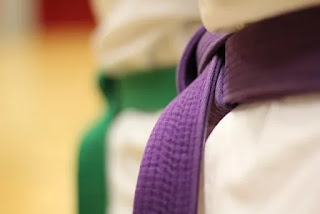Title: The Art of Evading Strikes: A Deep Dive into Martial Arts Focused on Defense
Introduction
In the vast world of martial arts, combat disciplines have historically emphasized offensive and defensive techniques. However, some martial arts prioritize the art of evading strikes and defensive manoeuvres over aggressive attacks. These arts, known for their strategic brilliance and elusive nature, offer practitioners a unique set of skills to protect themselves while minimizing potential harm to their adversaries. In this blog post, we will explore several martial arts that specialize in not being struck and delve into their philosophies, techniques, training methods, and real-life applications.
1. Aikido: The Way of Harmony
Originating in Japan, Aikido is a martial art that focuses on redirecting an opponent's energy and using force against them. Founded by Morihei Ueshiba in the early 20th century, Aikido combines elements of traditional Japanese martial arts, including Jujitsu, Kenjutsu, and Aiki-jujitsu. The fundamental principle of Aikido is to blend and harmonize with the attacker, avoiding direct confrontation and using circular and flowing movements to neutralize aggression.
Techniques in Aikido often involve joint locks, throws, and pins to subdue opponents without causing harm. Training is done with a partner, fostering the development of sensitivity and timing crucial to evading strikes effectively. The philosophy of Aikido emphasizes compassion, non-resistance, and respect for all life, making it an art of self-defence that discourages unnecessary violence.
2. Wing Chun: The Art of Simplicity
Wing Chun, a Chinese martial art founded by the legendary Yim Wing Chun, is known for its simplicity, efficiency, and emphasis on close-range combat. Unlike many other martial arts that emphasize forceful blocking or parrying, Wing Chun practitioners employ techniques that redirect an opponent's strikes through a series of precise and economical movements.
Centerline theory is a fundamental concept in Wing Chun, which means attacking and defending along the shortest distance between two opponents. By remaining on the centerline, Wing Chun practitioners can control their adversary's movements and effectively avoid strikes. This martial art also focuses on developing sensitivity through Chi Sao (sticky hands) drills, which enhance a practitioner's ability to feel an opponent's intentions and respond with swift evasive actions.
3. Capoeira: The Dance of Deception
Originating in Brazil during the colonial era, Capoeira is an Afro-Brazilian martial art that artfully combines dance, acrobatics, and music. Capoeira was initially developed as a means for enslaved Africans to resist oppression, disguising combat techniques within dance-like movements to avoid detection by slaveholders. Today, Capoeira remains a unique martial art that places equal emphasis on evading strikes, defensive manoeuvres, and maintaining a playful, fluid style.
Capoeira practitioners, known as capoeiristas, perform a series of agile and acrobatic movements while maintaining a low stance, making it challenging for opponents to land strikes. The Ginga, a swaying back-and-forth movement, is a core component of Capoeira that enables practitioners to evade attacks and transition smoothly between defensive and offensive positions. Music and rhythm play a crucial role in Capoeira, enhancing the flow of movements and encouraging a sense of community among participants.
4. Systema: The Art of Adaptability
Developed in Russia, Systema is a martial art that focuses on natural movements, adaptability, and the concept of controlling an adversary through relaxation rather than tension. Unlike structured and stylized martial arts, Systema encourages practitioners to adapt their movements and techniques to the unique situations they encounter. The training encompasses strikes, grappling, and defence against multiple attackers, making it an excellent self-defence system for real-world scenarios.
Breathing exercises and relaxation techniques are key components of Systema training, enabling practitioners to maintain composure even in high-stress situations. By being aware of their bodies and surroundings, Systema practitioners can effortlessly avoid strikes and redirect an opponent's energy while using minimal force.
5. Krav Maga: The Art of Practical Self-Defense
Developed in Israel, Krav Maga is a martial art renowned for its practical and efficient self-defence techniques. Created for the Israeli Defense Forces, Krav Maga's primary focus is on neutralizing threats as quickly and effectively as possible, making it suitable for real-life situations. Krav Maga emphasizes instinctive movements and practical techniques that enable practitioners to evade, deflect, and counter strikes from any angle.
Training in Krav Maga includes simulated scenarios to prepare practitioners for real-world confrontations, instilling confidence and quick thinking. The art borrows techniques from boxing, judo, wrestling, and street-fighting, providing practitioners with a diverse skill set to escape dangerous situations unscathed.
Conclusion
Martial arts that prioritize defence over attack offer a unique perspective on combat and self-defence. While offensive techniques are undeniably valuable in certain situations, these defensive-focused arts allow practitioners to evade strikes, protect themselves, and neutralize adversaries without causing unnecessary harm. Each martial art discussed in this blog post presents distinct philosophies and techniques, highlighting the importance of adaptability, sensitivity, and the strategic use of energy in combat.
Whether it's the graceful blending of Aikido, the simplicity of Wing Chun, the dance-like artistry of Capoeira, the adaptability of Systema, or the practicality of Krav Maga, these martial arts offer valuable lessons for personal growth, self-discipline, and self-defence. By studying and practising these arts, individuals can enhance their physical fitness, mental acuity, and ability to navigate challenging situations with confidence and grace. The art of evading strikes exemplifies the beauty and intelligence of martial arts, transcending mere physical combat to embody a profound philosophy of peace, self-mastery, and respect for life.
